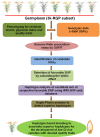Superior haplotypes towards development of low glycemic index rice with preferred grain and cooking quality
- PMID: 33980871
- PMCID: PMC8115083
- DOI: 10.1038/s41598-021-87964-8
Superior haplotypes towards development of low glycemic index rice with preferred grain and cooking quality
Abstract
Increasing trends in the occurrence of diabetes underline the need to develop low glycemic index (GI) rice with preferred grain quality. In the current study, a diverse set of 3 K sub-panel of rice consisting of 150 accessions was evaluated for resistant starch and predicted glycemic index, including nine other quality traits under transplanted situation. Significant variations were noticed among the accessions for the traits evaluated. Trait associations had shown that amylose content possess significant positive and negative association with resistant starch and predicted glycemic index. Genome-wide association studies with 500 K SNPs based on MLM model resulted in a total of 41 marker-trait associations (MTAs), which were further confirmed and validated with mrMLM multi-locus model. We have also determined the allelic effect of identified MTAs for 11 targeted traits and found favorable SNPs for 8 traits. A total of 11 genes were selected for haplo-pheno analysis to identify the superior haplotypes for the target traits where haplotypes ranges from 2 (Os10g0469000-GC) to 15 (Os06g18720-AC). Superior haplotypes for RS and PGI, the candidate gene Os06g11100 (H4-3.28% for high RS) and Os08g12590 (H13-62.52 as intermediate PGI). The identified superior donors possessing superior haplotype combinations may be utilized in Haplotype-based breeding to developing next-generation tailor-made high quality healthier rice varieties suiting consumer preference and market demand.
Conflict of interest statement
The authors declare no competing interests.
Figures




Similar articles
-
Superior haplotypes of key drought-responsive genes reveal opportunities for the development of climate-resilient rice varieties.Commun Biol. 2024 Jan 12;7(1):89. doi: 10.1038/s42003-024-05769-7. Commun Biol. 2024. PMID: 38216712 Free PMC article.
-
Effects of late-stage nitrogen fertilizer application on the starch structure and cooking quality of rice.J Sci Food Agric. 2018 Apr;98(6):2332-2340. doi: 10.1002/jsfa.8723. Epub 2017 Dec 13. J Sci Food Agric. 2018. PMID: 28991369
-
Effects of soluble starch synthase IIa allelic variation on rice grain quality with different Waxy backgrounds.J Sci Food Agric. 2020 Dec;100(15):5344-5351. doi: 10.1002/jsfa.10582. Epub 2020 Jul 16. J Sci Food Agric. 2020. PMID: 32533854
-
Rice with a healthier glycaemic profile: Unveiling the molecular mechanisms and breeding strategies for the future.Plant Physiol Biochem. 2025 Apr;221:109543. doi: 10.1016/j.plaphy.2025.109543. Epub 2025 Feb 1. Plant Physiol Biochem. 2025. PMID: 39952157 Review.
-
Posttranslational Modification of Waxy to Genetically Improve Starch Quality in Rice Grain.Int J Mol Sci. 2021 May 3;22(9):4845. doi: 10.3390/ijms22094845. Int J Mol Sci. 2021. PMID: 34063649 Free PMC article. Review.
Cited by
-
Superior haplotypes of key drought-responsive genes reveal opportunities for the development of climate-resilient rice varieties.Commun Biol. 2024 Jan 12;7(1):89. doi: 10.1038/s42003-024-05769-7. Commun Biol. 2024. PMID: 38216712 Free PMC article.
-
Identification of Superior Haplotypes and Haplotype Combinations for Grain Size- and Weight-Related Genes for Breeding Applications in Rice (Oryza sativa L.).Genes (Basel). 2023 Dec 12;14(12):2201. doi: 10.3390/genes14122201. Genes (Basel). 2023. PMID: 38137023 Free PMC article.
-
New insights into QTNs and potential candidate genes governing rice yield via a multi-model genome-wide association study.BMC Plant Biol. 2024 Feb 20;24(1):124. doi: 10.1186/s12870-024-04810-5. BMC Plant Biol. 2024. PMID: 38373874 Free PMC article.
-
Multi-model genome-wide association studies for appearance quality in rice.Front Plant Sci. 2024 Jan 11;14:1304388. doi: 10.3389/fpls.2023.1304388. eCollection 2023. Front Plant Sci. 2024. PMID: 38273959 Free PMC article.
-
Reverse genetic approaches for breeding nutrient-rich and climate-resilient cereal and food legume crops.Heredity (Edinb). 2022 Jun;128(6):473-496. doi: 10.1038/s41437-022-00513-5. Epub 2022 Mar 5. Heredity (Edinb). 2022. PMID: 35249099 Free PMC article.
References
-
- Khush, G.S., Paule, C.M. and Cruz, N.M. Rice grain quality evaluation and improvement at IRRI. In Proceedings of the Workshop on Chemical Aspects of Rice Grain Quality, IRRI, Los Banos, Philippines, pp. 21–31 (1979).
Publication types
MeSH terms
Substances
LinkOut - more resources
Full Text Sources
Other Literature Sources
Miscellaneous

